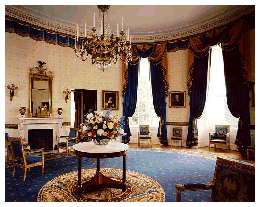
The "elliptic salon", with the Yellow Oval Room above and the Diplomatic Reception Room below it, formed the most elegant architectural feature of Hoban's plans for the White House. The Blue Room has always been used as a reception room except for a brief period during the administration of John Adams when it served as the south entrance hall. During the Madison Administration, architect Benjamin Latrobe designed a suite of classical-revival furniture for the room, but only some working drawings remain; the furnishings were destroyed in the fire of 1814.
When President Monroe redecorated the "large oval room" after the fire, he used the French Empire style, which is the present decor. Monroe ordered a suite of French mahogany furniture through the American firm Russell and La Farge, with offices in Le Havre, France. However, the firm shipped gilded furniture instead, asserting that "mahogany is not generally admitted into the furniture of a Saloon, even at private gentlemen's houses". Of the pieces Monroe ordered, eight remain, including a bergere, an armchair with enclosed sides. A bronze-dore clock also remains.
The color blue was first acquired during the administration of Martin Van Buren in 1837; he redecorated the oval salon and began the tradition of the "blue room".
You are looking at the marble-top center table, that has been in the White House since it was purchased by President Monroe in 1817, standing beneath the French gilded-wood chandelier. This early 19th-century chandelier is made from wood and cut glass, encircled with acanthus leaves. George P. A. Healy's 1859 portrait of John Tyler hangs on the west wall above the Bellange sofa. It is considered to be the finest in the series of Presidential portraits Healy painted for the White House under a commission from Congress.
A renovation and refurbishing of the Blue Room was initiated in the early 1990's by the Committee for The Preservation of the White House and completed in mid-1995. Hillary Rodham Clinton served as honorary chair of the committee and was actively involved in the project. The sapphire blue fabric used for the draperies and furniture covering is similar in color to fabric used in the room in 1800's. The silk upholstery fabric retains the gold eagle medallion on the chair backs which was adapted from the depiction of one of the Monroe-era chairs in a portrait of President James Monroe. The Monroe-era furniture, consisting of seven original chairs and four reproductions and a sofa, was upholstered by Nelson Beck of Washington, D.C.
The blue satin draperies have a blue and gold tape adapted from the wallpaper frieze, and are the same design as the previous draperies which were derived from an early 19th century French source. The drapery valances are blue and gold. As part of the refurbishing, the walls were hung with a light gold paper containing alternating classic motifs in a darker gold. This design was adapted from an early 19th century American paper in the collection of the Society for the Preservation of New England Antiquities in Boston, Massachusetts. The borders were adapted from two early 19th century French papers in the collection of the Cooper Hewitt National Design Museum, the Smithsonian Institution, in New York. The upper border is a blue drapery swag with gold classical motifs; the lower border along the chair rail has a blue and gold pattern with rosettes.
The Blue Room has been painted and gilded to reflect the style of finish found in an American room of the first quarter of the 19th century. The wainscoting, door surrounds and window reveals received extensive conservation to redefine their detailing. The woodwork was painted white with a rubbed paint finish giving the wood a "porcelain" appearance. The faux marble that was painted on the baseboards was removed during the renovation to reveal the white marble installed in the Truman era. The acanthus leaves in the cornice and the ceiling medallion were gilded, as were the three lines of molding in the cornice.
A major component of the recent renovation was the preservation and conservation of the historic furnishings in the room and of the early 19th century American "looking glass" which hangs over the mantel. This part of the project involved repairs and partial regilding of the items. Both the French gilded bronze clock and the mahogany center table were retained, and two 19th century pier tables and marble busts of Christopher Columbus and Amerigo Vespucci were added to the refurbished room.
Installation of a new oval carpet, based on early 19th century designs, completed the renovation project. The wool carpet chosen has a blue field with gold rosettes and an eight foot center medallion with classical motifs of scrolls, vines, flowers and lyres in cream, gold, red and blue. The design was adapted from an original design for a neoclassical English carpet of about 1815, the period of the furnishings acquired by President James Monroe for the Blue Room.
 |
 |
 |
President and First Lady | Vice President and Mrs. Gore
Record of Progress | The Briefing Room
Gateway to Government | Contacting the White House | White House for Kids
White House History | White House Tours | Help
Privacy Statement